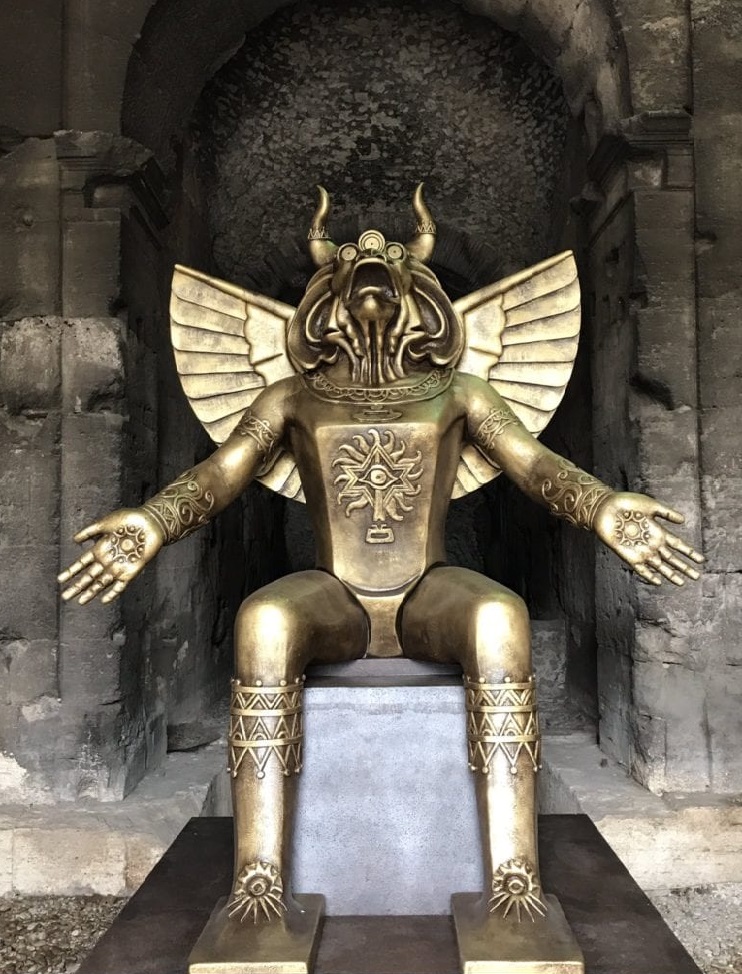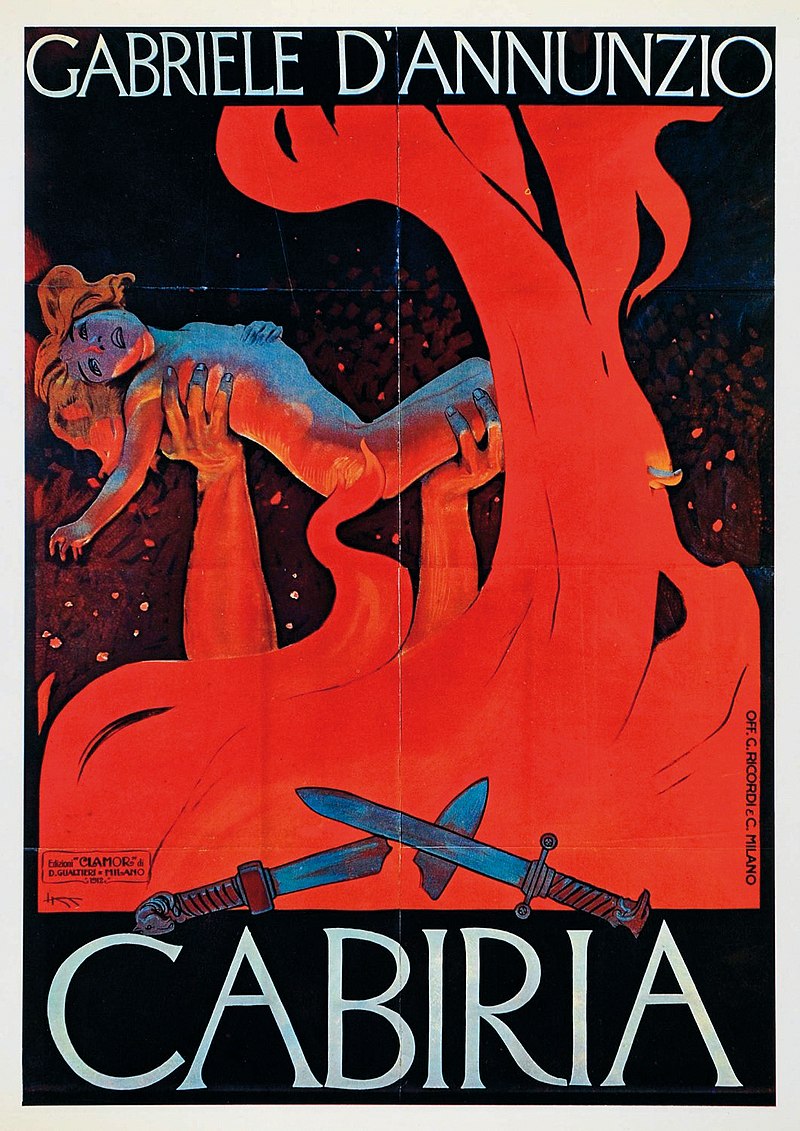
ROME – A statue of the Canaanite god Moloch is on display at the entrance to the Flavian Amphitheater, more commonly called the Colosseum. Despite conspiracy theories of Vatican involvement and concerns from fundamentalist groups, the display is part of a large-scale secular exhibition titled “Carthage: The immortal myth.” The exhibition was installed in the early autumn of 2019 and will run through March 29, 2020.
The display focuses on Carthage as one of the powerful cities of the ancient Mediterranean. The display is composed of items loaned from the National Archeological Museum in Italy, the Carthage National Museum, the Bordo in Tunisia, and the national museums of Beirut in Lebanon and Madrid and Cartagena in Spain.
The presence of the statue at the Colosseum has raised predictable concerns among Christian faithful, who have referred to it a demon god at a holy site. One person is reported as being horrified by the presence of the statue: “It was like they put Moloch there to mock the sacred place where the holy martyrs spilled their blood for the True Faith!”
The Colosseum is an iconic symbol of both Imperial and modern Rome, but it also links to the Catholic Church, as the Pope processes to the site every Good Friday during the rite called the Stations of the Cross. The Colosseum is the resting place of many Christian martyrs, and Pope Benedict XIV declared the Colosseum a sacred site by virtue of having been sanctified by their deaths.
Some conservative web sites insist the exhibition is an assault on Christianity and part of Satanic plots in Rome. In fact, the exhibition is a celebration of Carthage, including how the city has been depicted after its subordination to Rome and on through modernity.
According to the press-release by Parco archeologico del Colosseo (The Archeological Park of the Colosseum), the exhibition “features precious reconstructions and multimedia installations side-by-side with never before displayed artifacts, all the result of the research campaigns conducted by the Superintendency of the Sicilian Sea in the Aegadian Islands. Our goal is to help familiarize the public with the series of historical events that unite the two great powers of the ancient world, Carthage and Rome.”

Moloch at the Colosseum [via Twitter]
The statue at the Colosseum is one of those replicas. The original statue was in the 1914 epic silent film, Cabiria, directed by Giovanni Pastrone. The film depicts episodes from the Second Punic War, depicting Carthage as a city of atrocious rituals. It was loosely based on characters and stories from Livy’s History of Rome and 19th Century Italian fiction set in Carthage.
Moloch is attested to in the Torah numerous times and appears to be associated with war and child sacrifice. Leviticus 18:21 mentions him: “And thou shalt not let any of thy seed pass through the fire to Molech, neither shalt thou profane the name of thy God: I am the LORD.” In Leviticus 20:2-5 inveighs against the deity again:
Again, thou shalt say to the children of Israel, Whosoever he be of the children of Israel, or of the strangers that sojourn in Israel, that giveth any of his seed unto Molech; he shall surely be put to death: the people of the land shall stone him with stones. And I will set my face against that man, and will cut him off from among his people; because he hath given of his seed unto Molech, to defile my sanctuary, and to profane my holy name. And if the people of the land do any ways hide their eyes from the man, when he giveth of his seed unto Molech, and kill him not. Then I will set my face against that man, and against his family, and will cut him off, and all that go a whoring after him, to commit whoredom with Molech, from among their people.

Original Italian poster for Cabiria (1914) by Leopoldo Metlicovitz. Museo del Cinema [public domain]
Moloch is mentioned elsewhere in the Hebrew Bible in 2 Kings and Jeremiah.
The name, Moloch, is likely a theonym for “Great King.” The deity appears to have been important to Phoenicians and Ammonites as well. Greco-Roman authors associated Moloch with the titan Cronos, who also consumed his young. He appears to have also been associated with Bal Hammon, the male Supreme of the Carthaginian pantheon, who was responsible for the weather and crop fertility. The archeological record does appear to connect Moloch and his associated counterparts with child sacrifices.
Despite these brutal associations, Moloch has remained a literary favorite for millennia. John Milton references Moloch in “Paradise Lost” as first among his list of fallen angels: “First MOLOCH, horrid King besmear’d with blood/ Of human sacrifice, and parents tears,/ Though, for the noyse of Drums and Timbrels loud, / Their children’s cries unheard that passed through fire/ To his grim Idol.”
Bertrand Russel, mathematician and Nobel laureate in literature, used Moloch as an example of religious savagery in 1903: “The religion of Moloch — as such creeds may be generically called — is in essence the cringing submission of the slave, who dares not, even in his heart, allow the thought that his master deserves no adulation. Since the independence of ideals is not yet acknowledged, Power may be freely worshipped, and receive an unlimited respect, despite its wanton infliction of pain.”
H.G Wells mentions Moloch in The Time Machine (1895), and Fritz Lang shows a sacrificial temple to Moloch in the classic Metropolis (1927). In the 19th Century, Moloch became connected with abortion by anti-choice movements.
Even Winston Churchill – another Nobel laureate in literature- references Moloch in a comparison to Hitler: “He had called from the depths of defeat the dark and savage furies latent in the most numerous, most serviceable, ruthless, contradictory and ill-starred race in Europe. He had conjured up the fearful idol of an all-devouring Moloch of which he was the priest and incarnation.”
The exhibition in Rome depicts Moloch in the context of the spread of Mediterranean culture from the east and the rise of Rome and its ultimate domination of the region. The press release notes, “Visitors will embark on a journey starting from the foundation of the Phoenician East to the refounding of the new Colonia Iulia Concordia Carthago, touching upon important events in the rise of Christianity, the new religion of which Carthage would become an important center of diffusion. The exhibition concludes with an epilogue on the ancient city’s rediscovery in the light of the modern and contemporary imagination.”
The Wild Hunt is not responsible for links to external content.
To join a conversation on this post:
Visit our The Wild Hunt subreddit! Point your favorite browser to https://www.reddit.com/r/The_Wild_Hunt_News/, then click “JOIN”. Make sure to click the bell, too, to be notified of new articles posted to our subreddit.